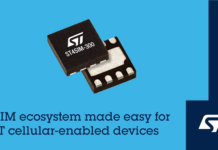
Energy drink brand Red Bull recently teamed with AT&T to globally connect up to 1 million of the company’s beverage coolers though the telecommunication firm’s IoT (Internet of Things) solution.
The rollout allows Red Bull to track and manage “the supply and demand of the coolers to make sure that the beverages are cold and ready for shoppers, and help provide efficiency for workers who no longer have to check the status of the units manually,” AT&T said.
The launch of the solution follows the increased piloting and implementation of IoT programs at retailers and brands such as Target Corp., Best Buy and Staples, among others. Engineers are working on ways to embed products and devices with connected technologies. This includes items in the home such as refrigerators and washers, and other appliances. And they’re also looking to retrofit existing products and machines — from escalators and elevators to shopping carts and commercial air conditioners.
AT&T has worked on embedding IoT technologies in the after-market car and truck sector for more than a decade. But connected products and devices are poised to experience exceptional growth as companies realize the benefits of big data, noted Shiraz Hasan, assistant vice president of IoT solutions at AT&T.
In a recent mobile technology report from Ericsson, researchers are predicting that between now and 2021, “IoT is expected to increase at a compounded annual growth rate (CAGR) of 23 percent, making up close to 16 billion of the total forecast 28 billion connected devices in 2021.”
With the IoT solution, AT&T said the data generated “will help ensure beverages are cold and ready for shoppers. The solution will also help identify issues as they appear — or even before.”
An AT&T company spokesperson said “alerts from coolers mean workers may no longer need to check the status of each unit manually. Precise data sent from the coolers will give near instant access to performance, temperature stats and geo-location information.”
The data is sent via AT&T’s global SIM network, Hasan said, noting that results are compiled and analyzed by using the company’s dashboard. It is all done in real time, he said, adding that the goal is to increase visibility and streamline processes.
In the consumer and retail space, Hasan said the deployment of IoT technology is “picking up” with the ongoing launches of wearables, which include devices that measure physical activity as well as medical devices that monitor health. “But the [retail and consumer] space has been slow to adopt,” he added.
Hasan said the data generated from IoT connected devices can help brands and companies make “better informed business decisions.” The data can also reveal how products and devices are used, which can help inform product development as well. Moreover, IoT can be used to create personalized “marketing moments” with consumers. Hasan said, for example, that gas pumps are now being equipped with video screens for showing short commercial videos. “Imagine seeing a personalized marketing message instead — that’s what IoT can enable,” he said.
Other applications of IoT include creating a “connected home.” And due to the real-time data generated, product developers and entrepreneurs can gather valuable lessons as products are used. Gene Han, vice president of consumer Internet of Things (IoT) and head of Target’s innovation office, said in a blog post earlier this year that the retailer’s “Open House” lab has been gathering insights from consumers while spurring ideas from brands and entrepreneurs since it opened in 2015.
This past winter, Open House reopened after a renovation and redesign. Han said the format is designed to “demystify connected home technology for consumers and give entrepreneurs a space to showcase their products.” The redesign includes a “retail shelf” where companies can launch products and “get valuable quantitative and qualitative feedback on their products and have direct visibility to Target buyers,” Han said. “We’re making it easier for startups to get their products in front of thousands of guests earlier, before they’re even available for sale.”
By Arthur Zaczkiewicz
Source: wwd.com


















